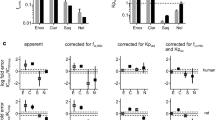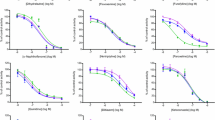Abstract
When the metabolism of a drug is competitively or noncompetitively inhibited by another drug, the degree of in vivo interaction can be evaluated from the [I]u/Ki ratio, where [I]u is the unbound concentration around the enzyme and Ki is the inhibition constant of the inhibitor. In the present study, we evaluated the metabolic inhibition potential of drugs known to be inhibitors or substrates of cytochrome P450 by estimating their [I]u/Ki ratio using literature data.
The maximum concentration of the inhibitor in the circulating blood ([I]max), its maximum unbound concentration in the circulating blood ([I]max,u), and its maximum unbound concentration at the inlet to the liver ([I]in,max,u) were used as [I]u, and the results were compared with each other. In order to calculate the [I]u/Ki ratios, the pharmacokinetic parameters of each drug were obtained from the literature, together with their reported Ki values determined in in vitro studies using human liver microsomes.
For most of the drugs with a calculated [I]in,max,u/Ki ratio less than 0.25, which applied to about half of the drugs investigated, no in vivo interactions had been reported or “no interaction” was reported in clinical studies. In contrast, the [I]max,u/Ki and [I]max/Ki ratio was calculated to be less than 0.25 for about 90% and 65% of the drugs, respectively, and more than a 1.25-fold increase was reported in the area under the concentration-time curve of the co-administered drug for about 30% of such drugs. These findings indicate that the possibility of underestimation of in vivo interactions (possibility of false-negative prediction) is greater when [I]max,u or [I]max values are used compared with using [I]in,max,u values.
Similar content being viewed by others
References
Ito K, Iwatsubo T, Kanamitsu S, Ueda K, Suzuki H, Sugiyama Y. Prediction of pharmacokinetic alterations caused by drug-drug interactions. Pharmacol Rev. 1998;50:387–411.
Lin JH, Lu AYH. Inhibition and induction of cytochrome P450 and the clinical implications. Clin Pharmacokin. 1998;35:361–390.
Bertz RJ, Granneman GR. Use of in vitro and in vivo data to estimate the likelihood of metabolic pharmacokinetic interactions. Clin Pharmacokin. 1997;32:210–258.
Kanamitsu S, Ito K, Sugiyama Y. Quantitative prediction of in vivo drug-drug interactions from in vitro data based on physiological pharmacokinetics: use of maximum unbound concentration of inhibitor at the inlet to the liver. Pharm Res. 2000;17:336–343.
Ito K, Iwatsubo T, Kanamitsu S, Nakajima Y, Sugiyama Y. Quantitative prediction of in vivo drug clearance and drug interactions from in vitro data on metabolism together with binding and transport. Annu Rev Pharmacol Toxicol. 1998;38:461–499.
Kobayashi S. Drug interactions. In: Japanese Society of Clinical Pharmacology and Therapeutics, ed. Rinsho Yakurigaku. Tokyo: Igakushoin; 1996:188–199.
Parkinson A. Biotransformation of xenobiotics. In: Klaassen CD. ed. Casarett & Doull's Toxicology, The Basic Science of Poisons. 5th ed. New York, NY: McGraw-Hill, Inc; 1996:113–186.
Oberle RL, Chen T-S, Lloyd C, et al. The influence of the interdigestive migrating myoelectric complex on the gastric emptying of liquids. Gastroenterology. 1990;99:1275–1282.
Tartini R, Kappenberger L, Steinbrunn W, Meyer UA. Dangerous interaction between amiodarone and quinidine. Lancet. 1982;1:1327–1329.
Saal AK, Werner JA, Gross BW, et al. Interaction of amiodarone with quinidine and procainamide. Circulation. 1982;66(suppl 2):224.
Sato J, Nakata H, Owada E, Kikuta T, Umetsu M, Ito K. Influence of usual intake of dietary caffeine on single-dose kinetics of theophylline in healthy human subjects. Eur J Clin Pharmacol. 1993;44:295–298.
Breen KJ, Bury R, Desmond PV, et al. Effects of cimetidine and ranitidine on hepatic drug metabolism. Clin Pharmacol Ther. 1982;31:297–300.
Kirch W, Spahn H, Kohler H, Ohnhaus EE, Mutschler E. Interaction of metoprolol, propranolol and atenolol with concurrent administration of cimetidine. Klin Wochenschr. 1982;60:1401–1407.
Pourbaix S, Desager JP, Hulhoven R, Smith RB, Harvengt C. Pharmacokinetic consequences of long term coadministration of cimetidine and triazolobenzodiazepines, alprazolam and triazolam, in healthy subjects. Int J Clin Pharmacol Ther Toxicol. 1985;23:447–451.
Raoof S, Wollschlager C, Khan FA. Ciprofloxacin increases serum levels of theophylline. Am J Med. 1987;82:115–118.
Syvälahti EKG, Taiminen T, Saarijärvi S, et al. Citalopram causes no significant alterations in plasma neuroleptic levels in schizophrenic patients. J Int Med Res. 1997;25:24–32.
Lee BL, Medina I, Benowitz NL, Jacob P, Wofsy CB, Mills J. Dapsone, trimethoprim, and sulfamethoxazole plasma levels during treatment of Pneumocystis pneumonia in patients with the acquired immunodeficiency syndrome (AIDS): evidence of drug interactions. Ann Intern Med. 1989;110:606–611.
Kondo T, Tanaka O, Otani K, et al. Possible inhibitory effect of diazepam on the metabolism of zotepine, an antipsychotic drug. Psychopharmacology Berl. 1996;127:311–314.
Kunzendorf U, Walz G, Brockmoeller J, et al. Effects of diltiazem upon metabolism and immunosuppressive action of cyclosporine in kidney graft recipients. Transplantation. 1991;52:280–284.
Kunzendorf U, Walz G, Brockmoeller J, et al. Effects of diltiazem upon metabolism and immunosuppressive action of cyclosporine in kidney graft recipients. Transplantation. 1991;52:280–284.
Glue P, Banfield CR, Perhach JL, Mather GG, Racha JK, Levy RH. Pharmacokinetic interactions with felbamate: in vitro-in vivo correlation. Clin Pharmacokinet. 1997;33:214–224.
Haefeli WE, Bargetzi MJ, Follath FF, Meyer UA. Potent inhibition of cytochrome P450IID6 (debrisoquin 4-hydroxylase) by flecainide in vitro and in vivo. J Cardiovasc Pharmacol. 1990;15:776–779.
Black DJ, Kunze KL, Wienkers LC, et al. Warfarin-fluconazole. II. A metabolically based drug interaction: in vivo studies. Drug Metab Dispos. 1996;24:422–428.
Varhe A, Olkkola KT, Neuvonen PJ. Effect of fluconazole dose on the extent of fluconazole-triazolam interaction. Br J Clin Pharmacol. 1996;42:465–470.
Bergstrom RF, Peyton AL, Lemberger L. Quantification and mechanism of the fluoxetine and tricyclic antidepressant interaction. Clin Pharmacol Ther. 1992;51:239–248.
Transon C, Leemann T, Vogt N, Dayer P. In vivo inhibition profile of cytochrome P450TB (CYP2C9) by (+/-)-fluvastatin. Clin Pharmacol Ther. 1995;58:412–417.
Sperber AD. Toxic interaction between fluvoxamine and sustained release theophylline in an 11-year-old boy. Drug Saf. 1991;6:460–462.
Ereshefsky L, Riesenman C, Lam YWF. Antidepressant drug interactions and the cytochrome P450 system (The role of cytochrome P450 2D6). Clin Pharmacokinet. 1995;29s:10–19.
Fleishaker JC, Hulst LK. A pharmacckinetic and pharmacodynamic evaluation of the combined administration of alprazolam and fluvoxamine. Eur J Clin Pharmacol. 1994;46:35–39.
Islam SI, Masuda QN, Bolaji OO, Shaheen FM, Sheikh IA. Possible interaction between cyclosporine and glibenclamide in posttransplant diabetic patients. Ther Drug Monit. 1996;18:624–626.
Kakuda TN, Struble KA, Piscitelli SC. Protease inhibitors for the treatment of human immunodeficiency virus infection. Am J Health-Syst Pharm. 1998;55:233–254.
Varhe A, Olkkola KT, Neuvonen PJ. Oral triazolam is potentially hazardous to patients receiving systemic antimycotics ketoconazole or itraconazole. Clin Pharmacol Ther. 1994;56:601–607.
von Moltke LL, Greenblatt DJ, Harmatz JS, et al. Triazolam biotransformation by human liver microsomes in vitro: effects of metabolic inhibitors and clinical confirmation of a predicted interaction with ketoconazole. J Pharmacol Exp Ther. 1996;276:370–379.
Joeres R, Richter E. Mexiletine and caffeine elimination. N Engl J Med. 1987;317:117.
Preston KL, Griffiths RR, Cone EJ, Darwin WD, Gorodetzky CW. Diazepam and methadone blood levels following concurrent administration of diazepam, methadone. Drug Alcohol Depend. 1986;18:195–202.
Klintmalm G, Sawe J. High dose methylprednisolone increases plasma cyclosporin levels in renal transplant recipients. Lancet. 1984;1(8379):731.
O'Reilly RA, Goulart DA, Kunze KL, et al. Mechanisms of the stereoselective interaction between miconazole and racemic warfarin in human subjects. Clin Pharmacol Ther. 1992;51:656–667.
Greene DS, Barbhaiya RH. Clinical pharmacokinetics of nefazodone. Clin Pharmacokinet. 1997;33:260–275.
Robinson DS, Roberts DL, Smith JM, et al. The safety profile of nefazodone. J Clin Psychiatry. 1996;57(suppl 2):31–38.
Cantarovich M, Hiesse C, Lockiec F, Charpentier B, Fries D. Confirmation of the interaction between cyclosporine and the calcium channel blocker nicardipine in renal transplant patients. Clin Nephrol. 1987;28:190–193.
Hippius M, Henschel L, Sigusch H, Tepper J, Brendel E, Hoffmann A. Pharmacokinetic interactions of nifedipine and quinidine. Pharmazie. 1995;50:613–616.
Gugler R, Jansen JC. Omeprazole inhibits oxidative drug metabolism. Gastroenterology. 1985;89:1235–1241.
Özdemir V, Naranjo CA, Hermann N, Reed K, Sellers EM, Kalow W. Paroxetine potentiates the central nervous system side effects of perphenazine: contribution of cytochrome P4502D6 inhibition in vivo. Clin Pharmacol Ther. 1997;62:334–347.
Bonnabry P, Desmeules J, Rucaz S, Leemann T, Veuthey JL, Dayer P. Stereoselective interaction between piroxicam and acenoccumarol. Br J Clin Pharmacol. 1996;41:525–530.
Ptachcinski RJ, Venkataramanan R, Burckart GJ, et al. Cyclosporine_high-dose steroid interaction in renal transplant recipients: assessment by HPLC. Transplant Proc. 1987;19:1728–1729.
Kowey PR, Kirsten EB, Fu CJ, Mason WD. Interaction between propranolol and propafenone in healthy volunteers. J Clin Pharmacol. 1989;29:512–517.
Schellens JHM, Ghabrial H, van der Wart HHF, Bakker EN, Wilkinson GR, Breimer DD. Differential effects of quinidine on the disposition of nifedipine, sparteine, and mephenytoin in humans. Clin Pharmacol Ther. 1991;50:520–528.
von Moltke LL, Greenblatt DJ, Duan SX, Daily JP, Harmatz JS, Shader RI. Inhibition of desipramine hydroxylation (cytochrome P450-2D6) in vitro by quinidine and by viral protease inhibitors: relation to drug interactions in vivo. J Pharm Sci. 1998;87:1184–1189.
Hsu A, Granneman GR, Cao G, Carothers L, et al. Pharmacokinetic interactions between two human immunodeficiency virus protease inhibitors, ritonavir and saquinavir. Clin Pharmacol Ther. 1998;63:453–464.
Nemeroff CB, DeVance CL, Pollock BG. Newer antidepressants and the cytochrome P450 system. Am J Psychiatry. 1996;153:311–320.
Veronese ME, Miners JO, Randles D, Gregov D, Birkett DJ. Validation of the tolbutamide metabolic ratio for population screening with use of sulfaphenazole to produce model phenotypic poor metabolizers. Clin Pharmacol Ther. 1990;47:403–411.
Toon S, Low LK, Gibaldi M, et al. The warfarin-sulfinpyrazone interaction: stereochemical considerations. Clin Pharmacol Ther. 1986;39:15–24.
Lamberg TS, Kivisto KT, Neuvonen PJ. Lack of effect of terfenadine on the pharmacokinetics of the CYP3A4 substrate buspirone. Pharmacol Toxicol. 1999;84:165–169.
Yasui N, Tybring G, Otani K, et al. Effects of thioridazine, an inhibitor of CYP2D6, on the steady-state plasma concentrations of the enantiomers of mianserin and its active metabolite, desmethylmianserin, in depressed Japanese patients. Pharmacogenetics. 1997;7:369–374.
Appel S, Rufenacht T, Kalafsky G, et al. Lack of interaction between fluvastatin and oral hypoglycemic agents in healthy subjects and in patients with non-insulin-dependent diabetes mellitus. Am J Cardiol. 1995;76:29A-32A.
Amchin J, Zarycranski W, Taylor KP, Albano D, Klockowski PM. Effect of venlafaxine on the pharmacokinetics of alprazolam. Psychopharmacol Bull. 1998;34:211–219.
Author information
Authors and Affiliations
Corresponding author
Additional information
Published: October 7, 2002
Rights and permissions
About this article
Cite this article
Ito, K., Chiba, K., Horikawa, M. et al. Which concentration of the inhibitor should be used to predict in vivo drug interactions from in vitro data?. AAPS J 4, 20 (2002). https://doi.org/10.1208/ps040425
Received:
Accepted:
Published:
DOI: https://doi.org/10.1208/ps040425




